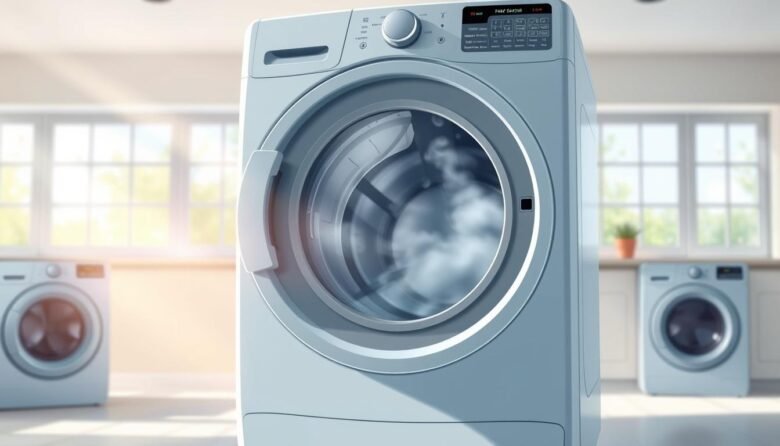That unpleasant musty smell coming from your laundry room isn’t just annoying—it’s a sign something needs attention. Many homeowners experience this common issue with their appliances.
Trapped moisture and product buildup create perfect conditions for mold and mildew growth. This leads to those stubborn odors that can transfer to your clothes.
Regular maintenance is crucial for keeping your washer fresh and functional. Our comprehensive guide provides effective solutions using simple household ingredients.
You’ll discover step-by-step methods suitable for all washer types. These approaches will restore freshness and extend your appliance’s lifespan.
Key Takeaways
- Musty smells indicate moisture buildup and potential mold growth in your appliance
- Regular maintenance prevents odor transfer to your laundry and clothes
- Simple household ingredients like vinegar effectively combat unpleasant odors
- Proper cleaning methods extend your washer’s lifespan and performance
- Different machine types require specific approaches for optimal results
- Preventative care stops odors from returning after treatment
- Fresh-smelling laundry begins with a clean washing machine
Understanding Why Your Washing Machine Develops Unpleasant Odors
Discovering the source of that persistent musty scent is crucial for effective treatment. Several factors combine to create the perfect environment for unwelcome smells.
Identifying these elements helps you target the right areas during maintenance. This knowledge prevents recurring issues with your appliance.
Common Causes of Musty Smells in Washers
Excess detergent creates a sticky film inside your unit. This residue traps moisture and bacteria, leading to persistent odors.
Front-load models are particularly susceptible due to their sealed design. Their rubber gaskets and dispensers create ideal moisture traps.
Infrequent maintenance allows grime and microorganisms to accumulate. This buildup becomes increasingly difficult to remove over time.
How Detergent and Fabric Softener Contribute to Odor Problems
Using too much soap leaves behind a sticky film. This coating becomes a breeding ground for bacteria and mold.
Fabric softeners deposit a waxy layer on internal components. This film promotes microbial adhesion and stubborn smells.
Always measure products according to manufacturer guidelines. Proper measurement prevents unnecessary residue accumulation.
Environmental Factors That Promote Mold and Mildew Growth
High humidity levels accelerate microbial development in laundry areas. Poor ventilation exacerbates this problem significantly.
Warm temperatures create ideal conditions for rapid mold expansion. Stagnant water from drainage issues introduces additional bacteria.
Dirty clothes and linens can introduce new microorganisms during each cycle. Regular cleaning prevents these contaminants from establishing colonies.
Understanding these causes empowers you to implement effective solutions. Proper maintenance keeps your laundry fresh and your appliance functioning optimally.
Essential Supplies for Effective Washing Machine Odor Removal
Having the correct tools and solutions on hand transforms a daunting task into a straightforward maintenance routine. Proper preparation ensures you can tackle stubborn issues efficiently without damaging your appliance.
Natural Cleaning Solutions: Vinegar and Baking Soda
White vinegar serves as a powerful natural cleaner for breaking down stubborn residue. Its acidic properties effectively sanitize surfaces and eliminate microbial growth.
Baking soda works wonders for neutralizing unpleasant scents without abrasive action. This gentle powder deodorizes while helping lift grime from surfaces.
Standard measurements include two cups of vinegar and half a cup of baking soda. These household staples offer affordable solutions that deliver impressive results.
Tools Needed for Thorough Drum Cleaning
Microfiber cloths prove essential for wiping interior surfaces without leaving lint. Their soft texture prevents scratches while absorbing moisture effectively.
Sponges provide gentle scrubbing action for tougher buildup areas. Small brushes reach into crevices around dispensers and seals.
Buckets serve multiple purposes during maintenance procedures. They mix solutions and catch water during drain cleaning processes.
Safety Equipment for Chemical Cleaning Methods
Rubber gloves protect your hands when working with stronger cleaning agents. Proper ventilation becomes crucial when using chemical products indoors.
Bleach offers deep sanitization for severe cases, with measurements varying by machine type. Never combine bleach with vinegar as this creates hazardous fumes.
Always consult manufacturer guidelines before using chemical cleaners. This prevents potential warranty issues and ensures compatibility with your specific model.
Most recommended supplies are readily available in typical households. Using appropriate equipment guarantees thorough maintenance without component damage.
Step-by-Step Guide to Front-Load Washing Machine Cleaning
Front-load washers require specific attention to maintain freshness and performance. Their sealed design creates unique challenges that demand targeted approaches.
This systematic process ensures thorough treatment of all critical areas. Follow these steps monthly for optimal results.
Preparing Your Front-Load Washer for Deep Cleaning
Begin with an empty unit to ensure unrestricted access. Remove any forgotten items from previous loads.
Check manufacturer guidelines for specific recommendations. This prevents potential damage during the process.
Gather all necessary supplies before starting. Proper preparation makes the entire procedure more efficient.
Cleaning the Door Gasket and Rubber Seals
The rubber seal demands careful inspection and treatment. Pull it back gently to reveal hidden areas.
Use a vinegar-water solution for scrubbing stubborn buildup. A soft brush reaches into crevices effectively.
Thorough drying prevents future microbial development. This critical step stops odors from returning between maintenance sessions.
Running Effective Cleaning Cycles with Natural Solutions
Add two cups of white vinegar directly into the drum. Run a hot water cycle to sanitize interior surfaces.
After completion, wipe all accessible areas with a microfiber cloth. This removes any lingering film or particles.
For persistent issues, add quarter-cup baking soda during an additional cycle. This natural combination neutralizes stubborn smells completely.
Regular maintenance keeps your laundry fresh and your appliance functioning optimally. Consistent care prevents most common problems with front-load units.
Comprehensive Top-Load Washing Machine Odor Removal Process
Top-load units require a different approach than their front-loading counterparts. Their open design presents unique challenges for freshness maintenance.
This thorough method targets all critical areas where grime accumulates. You’ll restore your appliance’s performance with simple household items.
Initial Preparation and Safety Measures
Always disconnect power before beginning any maintenance work. This prevents accidental activation during the process.
Check that the drum contains no forgotten garments or items. Remove any visible debris or loose particles manually.
Gather your supplies: white vinegar, baking soda, and cleaning tools. Having everything ready makes the task more efficient.
Agitator and Drum Cleaning Techniques
Fill the unit with hot water using the largest load setting. Add four cups of vinegar and one cup of baking soda.
Let this solution sit for sixty minutes to break down stubborn buildup. The combination works effectively against microbial growth.
After soaking, complete a full hot water cycle. This rinses away dissolved grime and cleaning residues.
Scrub the agitator with a soft brush if it’s removable. For fixed models, use a sponge with vinegar-water solution.
Dispenser and Lid Maintenance Procedures
Detach soap and softener compartments for individual attention. Soak them in warm, soapy water for thirty minutes.
Use an old toothbrush to scrub difficult-to-reach areas. Pay special attention to corners where product accumulates.
Wipe the underside of the lid and top rim thoroughly. These spots often harbor unnoticed residue.
Monthly deep cleaning prevents most common issues with top-load models. Consistent care keeps your laundry fresh and your unit functioning properly.
How to Clean Your Washing Machine Drain and Filter System
Proper drainage maintenance is essential for preventing unpleasant scents in your laundry area. Your appliance’s filter and hose components need regular attention to function correctly.
Clogged drains cause water to stagnate inside your unit. This creates perfect conditions for microbial growth and persistent issues.
Locating and Accessing Your Washer’s Drain Components
Begin by disconnecting power to your appliance for safety. This prevents electrical hazards during maintenance.
Find the access panel typically positioned at the front bottom. Many models feature a small door covering these parts.
Place towels and a shallow container beneath the area. This catches any water that might escape during the process.
Safe Drain Filter Removal and Cleaning Process
Slowly turn the filter cap to release trapped liquid. Allow all moisture to drain completely before full removal.
Wash the filter in warm soapy water using a soft brush. Remove lint, debris, and any stuck residues thoroughly.
Inspect for damage or excessive wear during cleaning. Regular maintenance prevents most drainage problems before they develop.
Inspecting and Clearing Drain Hose Obstructions
Check the hose connection for secure attachment. Look for kinks or bends that might restrict flow.
Run warm water through the tube to test for clogs. Use a flexible brush for stubborn blockages if needed.
Reassemble all components carefully after cleaning. Ensure proper seals to prevent leaks during operation.
Perform this maintenance every few months for best results. Consistent care keeps your laundry fresh and your appliance functioning properly.
Establishing an Effective Washing Machine Maintenance Schedule
A well-planned maintenance calendar serves as your first line of defense against persistent laundry appliance problems. Consistent care prevents residue accumulation and ensures your garments emerge fresh after every cycle.
Monthly Cleaning Routine for Optimal Performance
Implement a hot water cycle with two cups of white vinegar each month. This simple process breaks down soap film and keeps internal components spotless.
Households with heavy usage should clean every three to four weeks. Families with children or pets generate more grime requiring frequent attention.
Light users may extend intervals to six or eight weeks. Never completely skip this essential maintenance step for any appliance.
Seasonal Deep Cleaning Recommendations
Quarterly comprehensive care involves thorough inspections of all parts. Check drain hoses and clean dispensers during these sessions.
Hard water areas demand more frequent attention due to mineral deposits. Adjust your schedule based on local water quality conditions.
Seasonal maintenance enhances efficiency and extends appliance lifespan. This proactive approach saves money on repairs and replacements.
Signs You Need More Frequent Maintenance
Recurring musty smells indicate insufficient cleaning frequency. Clothes that don’t smell fresh after washing suggest needed attention.
Visible mold growth or slow drainage requires immediate action. Excess suds during cycles signal product buildup issues.
Error messages related to performance often stem from maintenance neglect. Keep a maintenance log with reminders for consistent care.
Always consult manufacturer guidelines for model-specific recommendations. Proper scheduling keeps your laundry fresh and your appliance reliable.
Proven Prevention Strategies to Keep Your Washer Fresh
Preventing unwanted scents in your laundry appliance requires consistent habits and smart practices. These simple strategies will help maintain a pleasant-smelling unit and fresh laundry results.
Proper Detergent Usage and Measurement Techniques
Using the correct amount of cleaning products prevents residue buildup. Always follow manufacturer guidelines for measurements.
High-efficiency units require specific detergents for optimal performance. These formulas create less suds and leave minimal film.
Accurate measurement stops excess soap from accumulating inside components. This simple habit maintains cleanliness between deep cleaning sessions.
Moisture Control and Ventilation Best Practices
After each cycle, leave the door slightly open to air out the interior. This allows moisture to evaporate completely.
Ensure your laundry space has adequate airflow through windows or fans. Reduced humidity prevents microbial growth.
Wipe down interior surfaces with a dry cloth to remove lingering dampness. Pay special attention to seals and dispensers.
Post-Wash Habits to Prevent Odor Development
Remove garments promptly after cycles finish. This prevents musty scents from developing on damp items.
Consider using vinegar instead of fabric softener during rinse cycles. It naturally softens clothes without leaving waxy residues.
Run hot water cycles periodically to break down oils and grime. Monthly maintenance with natural solutions keeps everything fresh.
Consistent care ensures your appliance remains pleasant-smelling and efficient. These practices protect your investment and improve laundry results.
Recommended Products for Odor-Free Laundry Results
Selecting the right laundry products makes a significant difference in maintaining appliance freshness. The market offers numerous solutions designed specifically for modern washers.
Quality products prevent common issues before they develop. They work with your maintenance routine for optimal results.
High-Efficiency Detergents That Prevent Residue Buildup
High-efficiency formulas create minimal suds during cycles. This characteristic helps prevent sticky film accumulation inside components.
Kind Laundry detergent sheets offer pre-measured portions for consistent use. Their low-residue formula rinses completely from fabrics and machines.
These products significantly reduce the risk of persistent smells by leaving no excess soap behind. Always use the recommended amount for your load size.
Specialized Washer Cleaning Products and Their Benefits
Affresh tablets and similar cleaners target grime during hot water cycles. They break down stubborn buildup in hard-to-reach areas.
Monthly use maintains interior cleanliness between deep cleaning sessions. These products sanitize surfaces without harsh chemical residues.
Specialized formulas work effectively with all machine types. They complement your regular maintenance routine for comprehensive care.
Natural Alternatives for Eco-Conscious Maintenance
White vinegar serves as an excellent disinfectant and deodorizer. Baking soda scrubs surfaces while neutralizing unpleasant scents.
Plant-based, biodegradable detergents offer gentle yet effective cleaning. These options work well for households seeking eco-friendly solutions.
Natural products minimize environmental impact while maintaining appliance health. They provide safe alternatives for families with sensitivity concerns.
Consider units with built-in odor prevention technology for long-term freshness. Speed Queen TR7 with Perfect Wash™ and LG Mega Capacity with TurboWash® offer advanced features.
Miele models provide AddLoad functionality and app connectivity for precise maintenance. Always verify product compatibility with your specific model before purchase.
Sample packs from brands like Kind Laundry let you test effectiveness first. This approach ensures you find the best solutions for your laundry needs.
Maintaining Long-Term Freshness in Your Laundry Routine
Sustaining a fresh-smelling appliance requires consistent daily habits. Proper detergent amounts and regular ventilation prevent residue buildup effectively.
Monthly deep cleaning with natural solutions keeps internal components spotless. Always wipe surfaces dry after cycles and remove laundry promptly.
These simple practices integrate seamlessly into your routine for effortless maintenance. Set calendar reminders to stay consistent with your schedule.
If persistent issues continue despite thorough care, consider professional consultation. Modern units with advanced features offer enhanced freshness technology.
Join online communities or subscribe to newsletters for ongoing tips. Your dedication ensures odor-free results and a healthier home environment for years.



